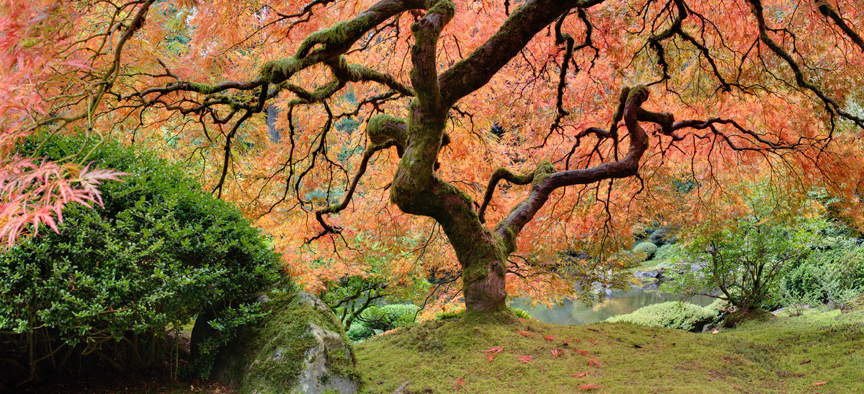Q. We have a six-year-old Coral Bark Japanese Maple. Last year, a few of the smaller branches turned black, and we pruned them off. Now one of the three main branches is doing the same thing, and the leaves are withering. The shape of the plant will be ruined if we remove it. What should we be doing?

A. It’s never good news when the stems of a Japanese Maple turn black. The black coloration is a primary indicator of a vascular disease called Verticillium Wilt. Verticillium Wilt is a soil-borne fungus disease that’s common in our Bay Area soils. When the infected stems are cut, you’ll find black streaking through the tissue. It attacks a wide range of ornamental and herbaceous plants including, tomatoes, peppers, roses, Pistache and Camphor trees. The fungus works its way up the plant from the roots disrupting the vascular tissue that is responsible for transporting water and nutrients throughout the plant. Unfortunately, we have no controls for this problem. The disease does attack without warning. Our poorly draining, heavy clay soil, and excessive summer watering doesn’t help. It’s particularly frustrating when Verticillium Wilt attacks established and thriving ornamentals. With tomatoes and other vegetables, we can plant resistant varieties, but that’s not the case with Japanese Maples. I’d removed the infected limb because it is not going to recover and encourage the new growth by feeding it an organic fertilizer. A replacement branch can be selected from the new growth. Leaf blight can also cause dark, deadened shoots and curled, darkened leaves on the tree. Airborne bacteria, such as Pseudomona is also responsible for leaf and branch dieback on a Japanese maple. But Verticillium Wilt is by far the primary suspect.
Q. How would I know if the hybrid vegetable seed I’ve planted has been genetically engineered? I’ve planted several hybrid crosses along with some heirloom tomatoes, and now I’m concerned that they may be unhealthy.
A. This shouldn’t be an issue, nor would I pull the plants and discard them. For generations, plant breeders have been cross-breeding the genes of compatible plants. Their goal is to create a new plant with the best traits from both parents such as early maturity, early flowering, disease-resistant, etc. The new plants are called F-1 Hybrids or just Hybrids. Seedless Watermelons and Pluots are recent examples of popular hybrids along with a countless number of tomatoes, other vegetables, and seasonal color plants. If you’re a seed saver, hybrids have a significant drawback and that they’re very unpredictable in the next generation, so it’s generally recommended not to waste your time saving the hybrid seed. Instead, you want to save open-pollinated varieties. Open Pollinated varieties are simply those varieties that are capable of producing seeds that will produce seedlings just like the parent plants. They breed exact traits year after year because of natural selection. Any variety that has been around a minimum of fifty years, an arbitrary number, are then called an Heirloom variety. These terms are often used interchangeably. F-1 Hybrids and Open-Pollinated varieties should not be confused with the modern-day gene splicing or genetically engineered plants. To be technical, USDA considers any plant, animal, or microorganism produced through any type of genetic modification as to be a genetically modified organism (GMO’s). While a hybrid plant is a GMO, it’s not genetically engineered. Genetically engineered varieties combine atypical genes that are not found in nature. The only way for them to occur is by human intervention and manipulation. Plants like corn that has the pesticide Bt engineered into its genetic makeup to make it resistant to certain pests is an example. Bt is a natural pesticide, but it would never naturally find its way into corn seed, they’re created using molecular genetics techniques such as gene cloning, slicing, and protein engineering. Another example, is herbicide-resistant soybean, cotton, canola, and alfalfa, so you control broad spectrum grasses and broadleaf weeds without damaging the original plant. These varieties have no application in home gardens. Hence, you will not encounter any packets of genetically engineered seed in home and garden catalogs or in the seed rack at their favorite garden centers.
Q. Can Epson Salt be applied at the same time you are adding a systemic fertilizer to roses? I don’t think there is a problem, but I’m just double-checking.
A. There is no problem applying Epson Salt with any other type of fertilizer. Epson Salt or Magnesium Sulfate is added as a supplement to traditional fertilizers. Magnesium is a secondary element necessary for plant growth that helps keep leaves green. With roses, it also stimulates the formation of basal canes or shoots. With old roses, this is an important method to rejuvenate the foundation canes.
Leave a Reply